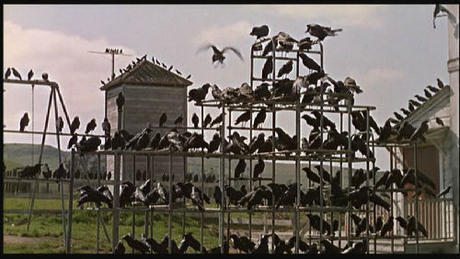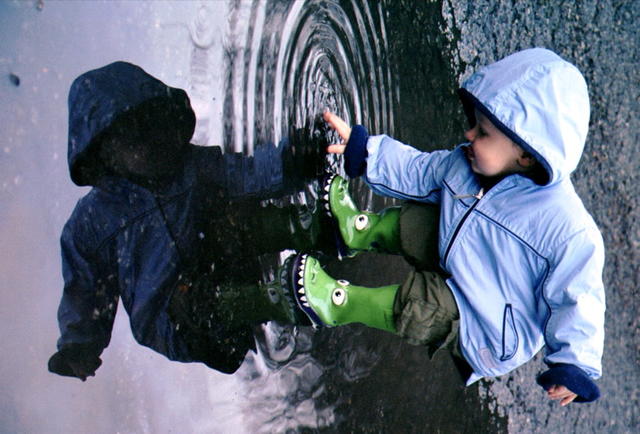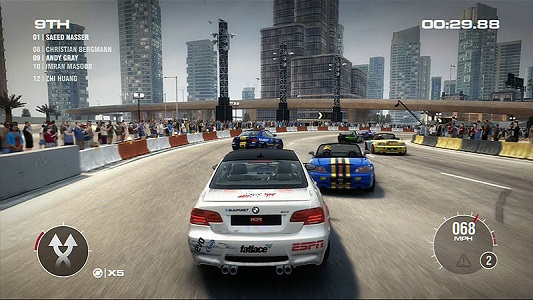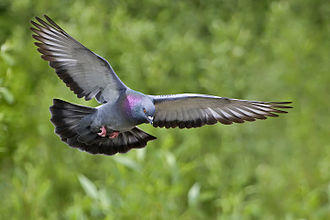By Siu-Lan Tan
Films trick our senses in many ways. Most fundamentally, there’s the illusion of motion as “moving pictures” don’t really move at all. Static images shown at a rate of 24 frames per second can give the semblance of motion. Slower frame rates tend to make movements appear choppy or jittery. But film advancing at about 24 frames per second gives us a sufficient impression of fluid motion.
However, birds–such as pigeons–have a much higher threshold for detecting movement. A bird’s visual system is keenly sensitive to moving stimuli as this is essential to their survival. Whether swooping down to snatch live prey, fleeing from a predator, or zeroing in on a nest for a precise landing, birds must rely on their fine-tuned ability to hone in on moving targets. So the frame rate at which most of our films are shown is far too slow for birds to perceive continuous motion. Their threshold of visual processing exceeds the standard frame rate, allowing them to see component frames … and the illusion of motion pictures would be broken.
If a pigeon had been roosting in the theater where 19th century crowds first gaped at the Lumière Brothers’ steam train looming towards them, it may have been less than impressed — especially as early silent films were often played at only 16 frames per second.
Click here to view the embedded video.
Even a film shown at today’s industry standard of 24 frames per second would most likely look like a series of flashing slides to a pigeon. We’re mesmerized by Marilyn Monroe’s white skirts billowing over the subway grate in The Seven-Year Itch, but a pigeon may see something more like a slide show of the skirt in frozen increments.
Further, most humans cannot distinguish individual lights flashed at 60 cycles per second, perceiving instead a single continuous beam of light. This gives an impression of constant light while watching a film (despite the shutter actually shutting out light several times per frame). But birds have much higher critical flicker-fusion frequency, such as 90-100 cycles per second or higher (e.g., Lisney et al., 2011). So while humans do not perceive the flicker in a movie, a pigeon may see flashes like strobelights along with the jumpy frames of Marilyn’s airborne skirt.
One of the creepiest scenes in Hitchcock’s The Birds shows Melanie (Tippi Hedren) smoking on a bench in a school playground while birds are flocking on a jungle gym behind her. She finally spots a lone bird flying overhead and turns around to discover every rung of the jungle gym crowded with large black birds. Actually, Hitchcock used cardboard cut-outs for most of the “birds” on the jungle gym, figuring that most people would not notice these stationary objects if interspersed with live birds.

Birds in a school playground in Hitchcock’s (1964) The Birds
Indeed, the illusion works on most of us. We are also often tricked by illusory “crowds” in films–made of real people and dummies, or multiple images of the same people patched together to make a “crowd”. However birds are especially observant of the movement of other birds–and combined with the much faster ‘refresh rate’ of the avian visual system (as their visual information is “updated” more frequently than humans)–the jungle gym scene would not likely fool any birds.
Studies suggest that birds do perceive some information via video images (using video at 30 frames per second). For instance, a video of wild chickens feeding elicits feeding in birds of the same species (McQuoid & Galef, 1993); videos showing a hawk or raccoon elicit aerial and ground alarm calls respectively in roosters (Evans, Evans, and Marler, 1993); and video images of female pigeons elicit courtship displays in male pigeons (Shimizu, 1998).
So birds seem to pick up some information from video images, at a somewhat higher frame rate and screen-refresh rate than film–though color may be distorted (Wright & Cumming, 1971), and gaps in movement and flicker are likely perceived (Lea & Dittrich, 1999). These discrepancies would be much more pronounced for moving images on cinematic film.
A fine-tuned visual system gives birds of prey an advantage when pursuing a fast-moving target. And it allows pigeons those few extra seconds to peck at grubs and seeds–and flap away at the last moment possible when your car approaches.
Nut their super-efficient processing of moving stimuli would make the cinematic experience as we know it less than spellbinding for the birds.
In conclusion: it’s interesting to note that film relies on certain limitations or imperfections of the human perceptual system for its magic to work!
Siu-Lan Tan is Associate Professor of Psychology at Kalamazoo College in Michigan, USA. She is primary editor of The Psychology of Music in Multimedia (Oxford University Press 2013), the first book consolidating the research on the role of music in film, television, video games, and computers. A version of this article also appears on Psychology Today. Siu-Lan Tan also has her own blog, What Shapes Film? Read her previous blog posts.
Subscribe to the OUPblog via email or RSS.
Subscribe to only psychology articles on the OUPblog via email or RSS.
The post Why you can’t take a pigeon to the movies appeared first on OUPblog.

By Siu-Lan Tan
It’s spring and about this time each year, a little ritual takes place. After the winter melt, many children encounter their first puddle with the zeal of an explorer discovering a new land.
Indeed, a puddle of water is a microcosm. In it, you find bits of sky, some leaves and a little froth, your own reflection. It is shallow and deep. It records your every step, augments your every move, but eventually leaves no trace that you were ever there. It is both moving and still. A mysterious thing is a puddle, and worth investigating.

After watching hours of YouTube videos of infants and toddlers stomping puddles of different sizes and shapes, I have come up with my list of “Eight Favorite Videos of Kids Discovering Puddles”—and will comment on them briefly as a developmental (child) psychologist. Take a moment to slow down and enjoy this mesmerizing medley, my ode to Spring!
#8 Boy meets first puddle
This toddler does a double-take when he first sees a puddle that has suddenly appeared in the front yard. What is that? He puts his toe in it, gasps, and takes a step back. His mother labels the experience (“Water. Puddle”), encouraging further exploration. He falls into the puddle, and gets back up again. It’s all of life in short review.
Click here to view the embedded video.
#7 Puddle splashing in Cape Breton
Ben, well-equipped in rain-gear, epitomizes Piaget’s portrait of the child as mini-scientist. Discovering a puddle for the first time, he performs repeated “tests” on this new watery universe—just like a scientist would, trying many new things to see the different effects. Piaget referred to these as circular reactions: actions repeated over and over again by the infant because the interesting effects compel the infant to try it again. Through these ‘circular reactions’, he repeatedly explores the shallow borders, touches the water with bare hands, wades into the deep middle, and examines the effects of moving in different pathways and stamping with alternating feet, on the responses of the water. His babbles punctuate his discoveries.
Click here to view the embedded video.
#6 Athena splashing in puddles—Spring 2014
Athena finds a puddle and exclaims “I’ve never seen it before!”. Piaget referred to our earliest kind of intelligence as “sensorimotor” as an infant uses her senses and motor actions to explore, and build a storehouse of knowledge about the physical world. Athena coordinates sight, touch, hearing, and action to examine the new puddle. We witness circular reactions again, this time with very fine variations. She intentionally alters the angle and speed of her foot taps, and is engrossed in observing the effects on the water—the contingencies of her actions, just like a scientist immersed in an experiment.
Click here to view the embedded video.
#5 Charlie discovers puddles
Charlie’s mother gives him time to explore on his own, and then responds to what has seized his interest. Developmental psychologists call this a joint attention episode, as child and parent are focused on the same thing. This’ joint attention episode’ is a natural teaching moment for acquiring new knowledge about the world, as well as developing language and expanding vocabulary—as the child learns all about the shared object of attention from his mother’s running commentary. “You’re in a puddle. Charlie, what does it feel like? Is it hot or cold? Is it wet or dry?”. (Charlie learns about properties of things, and new words, by direct experience). ”Do you see all the ripples you’re making? Just like the rain”. (The focus is now on cause and effect, perhaps a new word ‘ripple’). This is a master class in progress.
Click here to view the embedded video.
#4 Freya’s first puddle
Freya stops stomping puddles intermittently to look up and giggle with pure delight. While adults often dichotomize emotion and intellect, and researchers have focused mainly on the negative effects of emotion on learning, studies are beginning to suggest a link between positive emotions, such as joy and hope, and academic success (see, for example, Reinhard Pekrun). Freya’s gleeful responses show the natural joy that comes with learning, the exhilaration of discovering something new about the world around us.
Click here to view the embedded video.
#3 What if you encounter a mud puddle…when you’re driving your John Deere tractor?
This is an opportunity for Karsen to develop his cognitive skills—problem-solving—with a little advice from his father. Rather than running up to help and rescue the boy, dad instructs him on what to do from a distance. More than just the purely cognitive aspects of problem-solving, Karsen gains a sense of self-efficacy which may boost his ability on future tasks.
Click here to view the embedded video.
#2 Little girl in pink snowsuit discovers ice for the first time
This video has gone viral with almost one million views of the original post. The toddler finds a puddle that has frozen, and experiences ice for the first time. She’s somewhat younger than the other infants, and as she explores the ice patch with her feet and hands, she is constrained by her puffy snowsuit and proportions of her body. At this age, her head is one-fourth of her height (it is 1/8 in the typical adult) and her limbs are still relatively short. The consequences are worth seeing twice.
Click here to view the embedded video.
And the #1 video is… A Kid, a Dog, and a Puddle.
For this one, please read the commentary after watching.
Click here to view the embedded video.
This remarkable video has gone viral and is approaching eight million views. Okay, perhaps it’s not his first puddle but small bodies of water have not lost their luster for this boy. What’s most striking is the uncanny coordination between the boy (Arthur) and his dog (Watson), a sort of interactional synchrony (a matching of emotion and behavior, which allows for a ‘dialogue’ to take place through action). Arthur does not drop the leash carelessly but places it down gently, looking back at Watson twice—and the dog returns his gaze. The dog seems to sense the boy’s intentions and waits patiently for his companion. Arthur is immersed in sensorimotor activity through circular reactions, repeatedly running through the puddle. But he keeps his loyal dog in mind, and reunites quickly with his pal to continue their journey in step together.
As I sifted through scores of videos of infants and children stomping and splashing in puddles, I was reminded that play is a child’s work. The foundations of everything a child needs to learn across the domains—cognitive, emotional, and social—are learned through play.
This is so beautifully illustrated in a moment of curiosity, discovery, and joy of a child, evoked by a small pool of water left after the rain.
Siu-Lan Tan is Associate Professor of Psychology at Kalamazoo College in Michigan, USA. She is primary editor of The Psychology of Music in Multimedia (Oxford University Press 2013), the first book consolidating the research on the role of music in film, television, video games, and computers. A version of this article also appears on Psychology Today. Siu-Lan Tan also has her own blog, What Shapes Film? Read her previous blog posts.
Subscribe to the OUPblog via email or RSS.
Subscribe to only psychology articles on the OUPblog via email or RSS.
Image Credit: Jack in Puddle Photo by Robert Murphy. CC BY-SA 2.0 via Robert Murphy Flickr.
The post Splash! What kids discover in a puddle appeared first on OUPblog.

By Siu-Lan Tan
When playing video games, do you play better with the sound on or off? Every gamer may have an opinion, but what has research shown?
Some studies suggest that music and sound effects enhance performance. For instance, Tafalla (2007) found that male gamers scored almost twice as many points while playing the first-person shooter game DOOM with the sound on (chilling music, weaponfire, screams, and labored breathing) compared to those playing with the sound off.
On the other hand, Yamada et al. (2001) found that people had the fastest lap times in the racing game Ridge Racer V when playing with the music off. Interestingly, 10 different music tracks were tested—and the lowest scores were earned when playing with the soundtrack built into the game (Boom Boom Satellite’s “Fogbound”).
Sometimes the results are more complex. Cassidy and MacDonald (2009) tested people playing a driving game with car sounds effects alone or with car sound effects plus different kinds of music. People playing with music that had been shown to be ‘highly arousing’ (in previous research) drove the fastest—but also made the greatest number of mistakes, such as hitting barriers or knocking over road cones!

In our own research (published 2010 and 2012), my colleagues John Baxa and Matt Spackman and I found that people playing Twilight Princess (Legend of Zelda) performed worst when playing with both music and sound effects off. This game provides the player with rich auditory cues that function as warnings, clues for access points, feedback for correct moves such as successful attacks on enemies, and more. Many of these don’t just “double” what you see on the screen.
As we progressively added more game audio, performance improved. However, surprisingly, our participants performed best when playing with background music playing on a boombox that was unrelated to the game! (This would be like playing a game with the game sound switched off—while your roommate’s music is playing in the background.)
How to boost your game play?
So how do we make sense of these findings? And do they shed light on what distinguishes the top gamers?
A closer look at the individuals in our 2010/2012 study suggested that the majority of our participants—but not all—played better with unrelated background music until they “got the hang of” the game.
We used a game that was new to everybody. As Twilight Princess is a pretty complex adventure role-playing game, the average player seemed to have to focus attention on the visual information when first navigating the game. So music and sound effects built into the game may have interfered with their concentration, as they had to “tune it out” to focus on visual cues to guide their actions at first.

However, our top players (who concluded four days of play in our Videogame Lab with the highest scores) were different. They tended to play better with the game sound on (full music and sound effects coming from both screen and Wiimote) from the very beginning.
The best players seemed to be better at paying attention to and meaningfully integrating both audio and visual cues effectively—thus benefitting from the richest warnings/clues/feedback. While the typical player strongly favored one sense, the best players were truly playing an audio-visual game from the beginning.
So…one secret to being a successful gamer may be to sharpen your attention to audio cues (in sound effects and music) within a game. Paying more attention to and integrating cues to both ear and eye may boost your game!
More than just high scores…
I’m also reminded of what a participant in our study expressed so well: “There’s more to a game than just high scores. It’s also about being transported and immersed in another world, and music and sound effects are what bring you there.”
Indeed, the lush cinematic scores take us through the emotional highs and lows of the journey of a game. Atmospheric tracks immerse us in other worlds. Rhythmic tracks serve as an engine to drive the action, the propulsion of the music making the virtual environment appear deeper and the visual array seem to whizz by faster (motion parallax).
When you have a great soundtrack, music can be the soul of a game.
Postscript: Sonic Mayhem!
Recently I had a chance to speak with composer Sonic Mayhem (Sascha Dikiciyan) when we were both interviewed on video game music by Sami Jarroush for Consequence of Sound. Sonic Mayhem is one of the most sought-after video game music composers today. He scored Quake III Arena, Tron: Evolution, Mass Effect 2 & 3, Borderlands, Space Marine, James Bond: Tomorrow Never Dies, Mortal Kombat vs DC, and a ton of other monumental games.
Click here to view the embedded video.
Siu-Lan Tan is Associate Professor of Psychology at Kalamazoo College in Michigan, USA. She is primary editor of The Psychology of Music in Multimedia (Oxford University Press 2013), the first book consolidating the research on the role of music in film, television, video games, and computers. A version of this article also appears on Psychology Today. Siu-Lan Tan also has her own blog, What Shapes Film? Read her previous blog posts.
Subscribe to the OUPblog via email or RSS.
Subscribe to only psychology articles on the OUPblog via email or RSS.
Image credits: (1) Dubaj, by Danik9000, CC-BY-SA-3.0 via Wikimedia Commons. (2) Dataspel, by Magnus Fröderberg/norden.org, CC-BY-2.5 via Wikimedia Commons.
The post What’s the secret to high scores on video games? appeared first on OUPblog.








